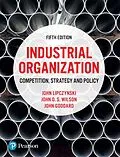This text enables a thorough and coherent understanding of the core concepts and key topics of industrial organisation using a firmly real-world and case-centric approach.
Industrial organisation draws upon contributions from a variety of fields of economic inquiry including game theory, information theory, organisation theory, agency theory, and transaction cost analysis, as well as the related field of strategic management.
The full text downloaded to your computer
With eBooks you can:
- search for key concepts, words and phrases
- make highlights and notes as you study
- share your notes with friends
eBooks are downloaded to your computer and accessible either offline through the Bookshelf (available as a free download), available online and also via the iPad and Android apps.
Upon purchase, you'll gain instant access to this eBook.
Time limit
The eBooks products do not have an expiry date. You will continue to access your digital ebook products whilst you have your Bookshelf installed.
Autorentext
Dr John Lipczynski is retired from the University sector. He contributes to the teaching and development of Executive MBA programmes in the private sector.
Professor John O.S. Wilson is Professor of Banking & Finance and Director of Research in the Management School at the University of St Andrews. He is Director for the Centre for Responsible Banking & Finance. His research interests include industrial organization and banking.
Professor John Goddard is Professor of Financial Economics and Deputy Head of Bangor Business School at Bangor University. His research interests include industrial organization, banking and the economics of professional football.
Inhalt
- Part I: Theoretical Foundations
- 1 Industrial organization: an introduction
- 1.1 Introduction
- 1.2 Static and dynamic views of competition
- 1.3 The structure-conduct-performance paradigm
- 1.4 Strategic management: a short diversion
- 2 Production, costs, demand and profit maximization
- 2.1 Introduction
- 2.2 Production and costs
- 2.3 Demand, revenue, elasticity and profit maximization
- 2.4 Summary
- 3 The neoclassical theory of the firm
- 3.1 Introduction
- 3.2 The neoclassical theory of the firm: historical development
- 3.3 Theories of perfect competition and monopoly
- 3.4 Efficiency and welfare properties of perfect competition and monopoly
- 3.5 Theory of monopolistic competition
- 3.6 Summary
- 4 Managerial and behavioural theories of the firm
- 4.1 Introduction
- 4.2 Critique of the neoclassical theory of the firm
- 4.3 Separation of ownership from control: managerial theories of the firm
- 4.4 The behavioural theory of the firm
- 4.5 Summary
- 5 Transaction costs, agency and resource-based theories of the firm
- 5.1 Introduction
- 5.2 The Coasian firm
- 5.3 Transaction costs and the theory of the firm
- 5.4 Agency theory
- 5.5 Property rights and the theory of the firm
- 5.6 The resource-based theory of the firm
- 5.7 Summary
- 6. Corporate governance
- 6.1 Introduction
- 6.2 Agency problems and the need for corporate governance
- 6.3 Instruments of corporate governance
- 6.4 Corporate governance codes of practice
- 6.5 Corporate governance: implementation and empirical evidence
- 6.6 Business ethics
- 6.7 Corporate social responsibility
- 6.8 Summary
- Part II: Structural Analysis of Industry
- 7 Oligopoly: non-collusive models
- 7.1 Introduction
- 7.2 Interdependence, conjectural variation, independent action and collusion
- 7.3 Models of output determination in duopoly
- 7.4 Models of price determination in duopoly
- 7.5 The kinked demand curve and models of price leadership
- 7.6 Summary
- 8 Oligopoly: collusive models
- 8.1 Introduction
- 8.2 Collusive action and collusive forms
- 8.3 Collusive institutions
- 8.4 Profit-maximizing models of price and output determination for a cartel
- 8.5 Other motives for collusion
- 8.6 Factors conducive to cartel formation
- 8.7 Influences on cartel stability
- 8.8 Summary
- 9 Game Theory
- 9.1 Introduction
- 9.2 Dominnce and Nash Equilibrium
- 9.3 The prisoner's dilemma game
- 9.4 Mixed strategies
- 9.5 Sequential Games
- 9.6 Repeated Games
- 9.7 Summary
- 10 Concentration: measurement and trends
- 10.1 Introduction
- 10.2 Market and industry definition
- 10.3 Official schemes for industry classification
- 10.4 Measures of seller concentration
- 10.5 Interpretation of concentration measures
- 10.6 Summary
- 11 Determinants of seller concentration
- 11.1 Introduction
